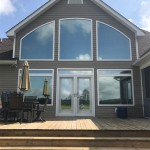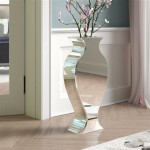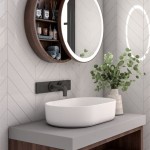```html
French Mantel Mirrors: A Timeless Elegance
French mantel mirrors, also known as overmantel mirrors, are architectural and decorative elements designed to be placed above a fireplace mantel. These mirrors are distinguished by their elaborate designs, incorporating stylistic elements that reflect different periods of French art and interior design. They have been a staple of European homes for centuries, evolving from purely functional objects to significant statements of wealth and artistic taste.
The allure of the French mantel mirror lies in its ability to transform a room. Beyond simply reflecting light and creating the illusion of more space, these mirrors inject character, history, and a touch of sophistication. The mirror's frame, often the focal point, can range from the understated elegance of the Louis XVI style to the ornate detailing characteristic of the Rococo period. Understanding the various styles and features associated with French mantel mirrors is key to appreciating their historical and aesthetic value.
Historical Development and Style Evolution
The history of French mantel mirrors is closely tied to the evolution of fireplace design and interior decorating trends. During the Renaissance, fireplaces began to transition from rudimentary necessities for heating into prominent architectural features. The introduction of glass mirrors during this period paved the way for their incorporation into fireplace surrounds.
The Baroque period, spanning the 17th and early 18th centuries, saw the rise of grand and elaborate mantel mirrors. These mirrors, often commissioned by royalty and the aristocracy, were designed to reflect their status and wealth. Gilded frames, intricate carvings, and the use of expensive materials like marble and exotic woods were common features. Symmetry and opulence were hallmarks of the Baroque aesthetic.
The Rococo period, following the Baroque, ushered in a lighter, more playful style. Rococo mantel mirrors were characterized by asymmetrical designs, flowing curves, and delicate ornamentation. Motifs drawn from nature, such as shells, flowers, and leaves, were frequently incorporated into the frames. Gold leaf remained a popular finish, but it was often applied with a softer, less formal touch.
The Neoclassical period, which emerged in the late 18th century, marked a return to classical ideals of order and simplicity. Louis XVI mantel mirrors reflected this shift in taste, featuring clean lines, symmetrical designs, and restrained ornamentation. Common motifs included geometric patterns, classical columns, and representations of ancient Greek and Roman figures. Painted finishes, particularly in soft pastel colors, gained popularity during this era.
The 19th century witnessed a revival of earlier styles, with mantel mirrors reflecting Victorian eclecticism. Mirrors from this period might incorporate elements from the Baroque, Rococo, and Neoclassical styles, often in a single piece. Mass production techniques also made mantel mirrors more accessible to a wider range of homeowners. The frames became increasingly ornate, with the use of plaster, gesso, and machine-carved details.
Key Features of French Mantel Mirrors
Identifying the key features of French mantel mirrors is essential for appreciating their craftsmanship and stylistic nuances. These features extend beyond the reflective surface of the mirror itself and encompass the frame, the ornamentation, and the overall design.
Frame Material and Construction: The frame is arguably the most important element of a French mantel mirror. Traditional frames were constructed from solid wood, such as oak, walnut, or mahogany. These woods were chosen for their durability and their ability to be carved and ornamented. The frame construction often involved intricate joinery techniques to ensure stability and longevity. Gilding, the application of thin layers of gold leaf, was a common finishing technique, providing a luxurious and reflective surface. In later periods, less expensive materials like plaster, gesso (a mixture of plaster and glue), and composition wood were used to create frames that mimicked the appearance of more expensive materials. The quality of the frame material and construction significantly impacts the overall value and authenticity of the mirror.
Ornamentation and Detailing: The ornamentation of a French mantel mirror frame is what defines its style and character. Baroque mirrors are known for their heavy, sculptural carvings, often featuring acanthus leaves, scrolls, and cartouches (decorative panels). Rococo mirrors are characterized by asymmetrical designs and naturalistic motifs, such as shells, flowers, and birds. Neoclassical mirrors feature geometric patterns, classical columns, and representations of ancient Greek and Roman figures. The quality of the carving and the level of detail are important factors to consider when evaluating a mantel mirror. Hand-carved details, while more expensive, demonstrate a higher level of craftsmanship compared to machine-carved or molded ornamentation.
Mirror Glass and Beveling: The quality of the mirror glass itself is another important consideration. Antique mirrors often have a slightly distorted reflection, which is a characteristic of older glass manufacturing techniques. This distortion can add to the charm and authenticity of the mirror. Beveled edges, where the edges of the glass are angled, are a common feature of many French mantel mirrors. Beveling adds depth and dimension to the mirror and enhances its overall aesthetic appeal. The presence of foxing (small black spots caused by oxidation) can also be an indicator of the mirror's age. While excessive foxing can detract from the mirror's appearance, a moderate amount can contribute to its antique character.
Incorporating French Mantel Mirrors into Modern Interiors
Despite their historical origins, French mantel mirrors can be seamlessly integrated into a wide range of modern interior styles. Their versatility stems from their ability to add a touch of elegance, sophistication, and visual interest to any space.
One popular approach is to place a French mantel mirror above a fireplace, regardless of whether the fireplace is functional or purely decorative. The mirror serves as a focal point, drawing the eye and creating a sense of grandeur. The size of the mirror should be proportionate to the size of the fireplace and the overall room. A large, ornate mirror can dominate a small room, while a small, understated mirror might get lost in a large space.
French mantel mirrors can also be used in other areas of the home, such as living rooms, dining rooms, and bedrooms. Placed above a console table or credenza, a mantel mirror can create a stylish and functional display. In a bedroom, a mantel mirror can be used as a dressing mirror, adding a touch of luxury to the space. The mirror's frame can be coordinated with other decorative elements in the room, such as furniture, artwork, and lighting fixtures. Mixing and matching different styles can create an eclectic and personal aesthetic.
When incorporating a French mantel mirror into a modern interior, it is important to consider the overall color palette and design scheme. A gilded mirror can add warmth and richness to a room with neutral colors, while a painted mirror can add a pop of color to a more subdued space. The mirror's frame can also be painted to match the walls or other decorative elements in the room. The key is to create a cohesive and balanced look that reflects your personal style.
Furthermore, consider the lighting in the room. The mirror will reflect any light sources, so it is important to position it in a way that maximizes its reflective properties. Natural light is ideal, but artificial lighting can also be used to enhance the mirror's effect. Dimmers can be used to adjust the lighting levels and create different moods. The mirror can also be used to reflect artwork or other decorative objects, creating a layered and visually interesting display.
Ultimately, the best way to incorporate a French mantel mirror into a modern interior is to experiment and find what works best for your individual space and style. These mirrors are timeless pieces that can add character, elegance, and a touch of history to any home.
```
14 French Style Mirrors So Much Better With Age

30 X 42 French Country Wall Mirror Brown Threshold Mirrors Fireplace Mantle Decor

French Style Fireplace Mirror Design Ideas

36 X 26 French Country Mantle Wood Mirror Natural Threshold Target

Gilt Mirror On French Fireplace Contemporary Living Room

Anthropologie Inspired Diy French Gold Mirror So Much Better With Age

Antique Country French Mantel Mirror

The Florence Over Mantle Antique Gold 189 00 Mirrors Cau Luxury Furniture And Rococo Reion Baroque French Style Specialist

French Mirror Baroque Rococo Antique

Anthropologie Inspired Diy French Gold Mirror So Much Better With Age








